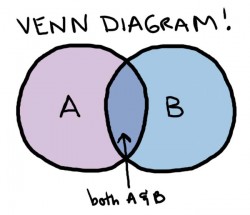I always find posts like this one by David Rotman in Technology Review puzzling. He says “the fundamental policy mistake that produced the Solyndra debacle” was that the 2009 stimulus bill “conflated two objectives: creating jobs and building a clean-energy infrastructure.”
It is true, as Rotman says, that laying the groundwork for a clean energy economy is a large-scale, long-term endeavor. It will require lots of investments — in basic science, new infrastructure, etc. — that won’t pay dividends for years to come. It is also true that the whole point of economic stimulus is to be spent quickly, to create jobs in the short term. The two objectives are not the same and of course one should not conflate or confuse them.
 Still, if you can picture a Venn diagram with clean energy development in one circle and economic stimulus in the other, there is some overlap. There are ways to advance clean energy development and create jobs in the short term. The set of such policies may not be large relative to either need — it may do only a moderate amount for clean energy and create only a moderate amount of jobs — but if a piece of legislation could capture a good chunk of that set, it would rightly be viewed on its own terms as a significant victory.
Still, if you can picture a Venn diagram with clean energy development in one circle and economic stimulus in the other, there is some overlap. There are ways to advance clean energy development and create jobs in the short term. The set of such policies may not be large relative to either need — it may do only a moderate amount for clean energy and create only a moderate amount of jobs — but if a piece of legislation could capture a good chunk of that set, it would rightly be viewed on its own terms as a significant victory.
And that’s what the stimulus bill was. A differently tailored piece of legislation could have created more jobs. A differently tailored piece of legislation could have done more to advance the clean energy economy. But the bill captured a good bit of the overlap. It was a f’ing huge green jobs bill. And the same goes for the loan guarantee program the bill created; it was designed to capture the overlap.
Politics is not a poli-sci grad school course. Politicians face a set of pressures that make it effectively impossible to accomplish each individual policy goal with perfectly tailored legislation. Particularly when it comes to U.S. politics, with all its choke points and dysfunctions, it is just extremely difficult to get anything done. (See: everything after the Recovery Act.)
When politicians design legislation to advance two distinct policy goals at once, they are not making some kind of analytic error. They are doing politics. They need the support of a broad coalition, so they kludge together bills that do a little of this, a little of that, none of it perfectly. C’est la vie.
Rotman says that trying to do clean energy development and economic stimulus at once made failures like Solyndra “inevitable.” But if that’s so, why is the other 98.7 percent of DOE’s loan portfolio doing fine?
Despite the epidemic of 20/20 hindsight happening right now, there were good reasons to believe that Solyndra inhabited the sweet spot where it could advance clean energy development and quickly create domestic jobs. And until the bottom fell out, it did. Now Rotman is doing what pretty much everyone has done: using Solyndra as support for his preexisting policy preferences.
As far as I’m concerned, there’s exactly one lesson to be learned from Solyndra: If you live in 2009, don’t bet against silicon.


